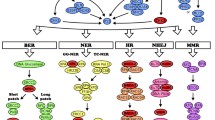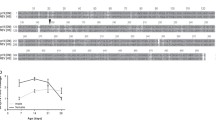Abstract
Repetitive DNA sequences that encode polyglutamine tracts are prone to expansion and cause highly deleterious phenotypes of neurodegeneration. Despite this tendency, polyglutamine tracts (“polyQs”) are conserved features of eukaryotic genomes. PolyQs are the most frequent protein-coding homotypic repeat in insect genomes, and are found predominantly in genes encoding transcription factors conserved from Drosophila through human. Although highly conserved across species, polyQ lengths vary widely within species. In D. melanogaster, polyQs in 25 genes have more alleles and higher heterozygosity than all other poly-amino acid tracts. The heat shock protein Hsp70 is a principal suppressor of polyQ expansions and may play a key role in modulating the phenotypes of the alleles that encode them. Hsp70 also promotes tolerance of natural thermal stress in Drosophila and diverse organisms, a role which may deplete the chaperone from buffering against polyQ toxicity. Thus in stressful environments, natural selection against long polyQ alleles more prone to expansion and deleterious phenotypes may be more effective. This hypothesis can be tested by measuring the phenotypic interactions between Hsp70 and polyQ transgenes in D. melanogaster undergoing natural thermal stress, an approach which integrates comparative genomics with experimental and ecological genetics.
Similar content being viewed by others
References
Alba M M, Santibanez-Koref M F and Hancock J M 2001 The comparative genomics of polyglutamine repeats: extreme differences in the codon organization of repeat-encoding regions between mammals and Drosophila; J. Mol. Evol. 52 249–259
Ambra R, Grimaldi B, Zamboni S, Filetici P, Macino G and Ballario P 2004 Photomorphogenesis in the hypogeous fungus Tuber borchii: isolation and characterization of Tbwc-1, the homologue of the blue-light photoreceptor of Neurospora crassa; Fungal Genet. Biol. 41 688–697
Andres A M, Lao O, Soldevila M, Calafell F and Bertranpetit J 2003 Dynamics of CAG repeat loci revealed by the analysis of their variability; Hum. Mutat. 21 61–70
Bettencourt B R, Kim I, Hoffmann A A and Feder M E 2002 Response to natural and laboratory selection at the Drosophila Hsp70 genes; Evolution 56 1796–1801
Bonini N M 2002 Chaperoning brain degeneration; Proc. Natl. Acad. Sci. USA 99 S4 16407–16411
Brignull H R, Moore F E, Tang S J and Morimoto R I 2006 Polyglutamine proteins at the pathogenic threshold display neuron-specific aggregation in a pan-neuronal Caenorhabditis elegans model; J. Neurosci. 26 7597–7606
Callewaert L, Christiaens V, Haelens A, Verrijdt G, Verhoeven G and Claessens F 2003 Implications of a polyglutamine tract in the function of the human androgen receptor; Biochem. Biophys. Res. Commun. 306 46–52
Chan E Y, Luthi-Carter R, Strand A, Solano S M, Hanson S A, DeJohn M M, et al 2002 Increased huntingtin protein length reduces the number of polyglutamine-induced gene expression changes in mouse models of Huntington’s disease; Hum. Mol. Genet. 11 1939–1951
Deka R, Guangyun S, Smelser D, Zhong Y, Kimmel M and Chakraborty R 1999 Rate and directionality of mutations and effects of allele size constraints at anonymous, gene-associated, and disease-causing trinucleotide loci; Mol. Biol. Evol. 16 1166–1177
Driscoll M and Gerstbrein B 2003 Dying for a cause: invertebrate genetics takes on human neurodegeneration; Nat. Rev. Genet. 4 181–194
Everett C M and Wood N W 2004 Trinucleotide repeats and neurodegenerative disease; Brain 127 2385–2405
Feder J H, Rossi J M, Solomon J, Solomon N and Lindquist S 1992 The consequences of expressing Hsp70 in Drosophila cells at normal temperatures; Genes Dev. 6 1402–1413
Feder M E, Blair N and Figueras H 1996 Natural thermal stress and heat-shock protein expression in Drosophila larvae and pupae; Func. Ecol. 11 90–100
Fernandez-Funez P, Nino-Rosales M L, de Gouyon B, She W C, Luchak J M, Martinez P, et al 2000 Identification of genes that modify ataxin-1-induced neurodegeneration; Nature (London) 408 101–106
Fujii K, Okiura T, Nishimura K, Orimoto C and Nishimukai H 2003 Short tandem repeat typing in exon 1 of the androgen receptor gene; Leg. Med. (Tokyo) 5 S201–S203
Gatchel J R and Zoghbi H Y 2005 Diseases of unstable repeat expansion: mechanisms and common principles; Nat. Rev. Genet. 6 743–755
Gong W J and Golic K G 2006 Loss of Hsp70 in Drosophila is pleiotropic, with effects on thermotolerance, recovery from heat shock and neurodegeneration; Genetics 172 275–286
Haber M, Schungel M, Putz A, Muller S, Hasert B and Schulenburg H 2005 Evolutionary history of Caenorhabditis elegans inferred from microsatellites: evidence for spatial and temporal genetic differentiation and the occurrence of outbreeding; Mol. Biol. Evol. 22 160–173
Herbst M and Wanker E E 2006 Therapeutic approaches to polyglutamine diseases: combating protein misfolding and aggregation; Curr. Pharm. Des. 12 2543–2555
Huang H, Rambaldi I, Daniels E and Featherstone M 2003 Expression of the Wdr9 gene and protein products during mouse development; Dev. Dyn. 227 608–614
Huttel B, Winter P, Weising K, Choumane W, Weigand F and Kahl G 1999 Sequence-tagged microsatellite site markers for chickpea (Cicer arietinum L.); Genome 42 210–217
Ishihara K, Yamagishi N, Saito Y, Adachi H, Kobayashi Y, Sobue G, et al 2003 Hsp105alpha suppresses the aggregation of truncated androgen receptor with expanded CAG repeats and cell toxicity; J. Biol. Chem. 278 25143–25150
Katsuno M, Sang C, Adachi H, Minamiyama M, Waza M, Tanaka F, et al 2005 Pharmacological induction of heat-shock proteins alleviates polyglutamine-mediated motor neuron disease; Proc. Natl. Acad. Sci. USA 102 16801–16806
Kazemi-Esfarjani P and Benzer S 2000 Genetic suppression of polyglutamine toxicity in Drosophila; Science 287 1837–1840
Kazemi-Esfarjani P and Benzer S 2002 Suppression of polyglutamine toxicity by a Drosophila homolog of myeloid leukemia factor 1; Hum. Mol. Genet. 11 2657–2672
Kim W Y, Horbinski C, Sigurdson W and Higgins D 2004 Proteasome inhibitors suppress formation of polyglutamine-induced nuclear inclusions in cultured postmitotic neurons; J. Neurochem. 91 1044–1056
Kittles R A, Young D, Weinrich S, Hudson J, Argyropoulos G, Ukoli F, et al 2001 Extent of linkage disequilibrium between the androgen receptor gene CAG and GGC repeats in human populations: implications for prostate cancer risk; Hum. Genet. 109 253–261
Kregel K C 2002 Heat shock proteins: modifying factors in physiological stress responses and acquired thermotolerance; J. Appl. Physiol. 92 2177–2186
Krebs R A and Feder M E 1997 Deleterious consequences of Hsp70 overexpression in Drosophila melanogaster larvae; Cell Stress Chap. 2 60–71
Krobitsch S and Lindquist S 2000 Aggregation of huntingtin in yeast varies with the length of the polyglutamine expansion and the expression of chaperone proteins; Proc. Natl. Acad. Sci. USA 97 1589–1594
Leggo J, Dalton A, Morrison P J, Dodge A, Connarty M, Kotze M J, et al. 1997 Analysis of spinocerebellar ataxia types 1, 2, 3, and 6, dentatorubral-pallidoluysian atrophy, and Friedreich’s ataxia genes in spinocerebellar ataxia patients in the UK; J. Med. Genet. 34 982–985
Michalakis Y and Veuille M 1996 Length variation of CAG/CAA trinucleotide repeats in natural populations of Drosophila melanogaster and its relation to the recombination rate; Genetics 143 1713–1725
Misra S, Crosby M A, Mungall C J, Matthews B B, Campbell K S, Hradecky P, et al 2002 Annotation of the Drosophila melanogaster euchromatic genome: a systematic review; Genome Biol. 3 RESEARCH0083
Mitsui K, Nakayama H, Akagi T, Nekooki M, Ohyawa K, Takio K, et al 2002 Purification of polyglutamine aggregates and identification of elongation factor-1a and heat shock protein 84 as aggregate-interacting proteins; J. Neurosci. 22 9267–9277
Muchowski PJ and Wacker JL 2005 Modulation of neurodegenera-tion by molecular chaperones; Nat. Rev. Neurosci. 6 11–22
Pearson C E, Edamura K N and Cleary J D 2005 Repeat instability: mechanisms of dynamic mutations; Nat. Rev. Genet. 6 729–742
Richards S, Liu Y, Bettencourt B R, Hradecky P, Letovsky S, Nielsen R, et al 2005 Comparative genome sequencing of Drosophila pseudoobscura: chromosomal, gene, and cis-element evolution; Genome Res. 15 1–18
Riley B E and Orr H T 2006 Polyglutamine neurodegenerative diseases and regulation of transcription: assembling the puzzle; Genes Dev. 20 2183–2192
Ritossa F 1962 A new puffing pattern induced by temperature shock and DNP in Drosophila; Experentia 18 571–573
Roberts S P and Feder M E 2000 Changing fitness consequences of Hsp70 copy number in transgenic Drosophila undergoing natural thermal stress; Func. Ecol. 14 353–357
Ross C A, Margolis R L, Becher M W, Wood J D, Engelender S, Cooper J K, et al. 1998 Pathogenesis of neurodegenerative diseases associated with expanded glutamine repeats: new answers, new questions; Prog. Brain. Res. 117 397–419
Rutherford S L and Lindquist S 1998 Hsp90 as a capacitor for morphological evolution; Nature. (London) 396 336–342
Sakahira H, Breuer P, Hayer-Hartl M K and Hartl F U 2002 Molecular chaperones as modulators of polyglutamine protein aggregation and toxicity; Proc. Natl. Acad. Sci. USA (Suppl 4.) 99 16412–16418
Sakai K, Yamada M, Sato T, Yamada M, Tsuji S and Takahashi H 2006 Neuronal atrophy and synaptic alteration in a mouse model of dentatorubral-pallidoluysian atrophy; Brain 129 2353–2362
Schaffar G, Breuer P, Boteva R, Behrends C, Tzvetkov N, Strippel N, et al. 2004 Cellular toxicity of polyglutamine expansion proteins: mechanism of transcription factor deactivation; Mol. Cell. 15 95–105
Sheu Y T, Zmuda J M, Cauley J A, Moffett S P, Rosen C J, Ishwad C, et al 2006 Nuclear receptor coactivator-3 alleles are associated with serum bioavailable testosterone, insulin-like growth factor-1, and vertebral bone mass in men; J. Clin. Endocrin. Metab. 91 307–331
Smith R C, Rosen K M, Pola R and Magrane J 2005 Stress proteins in Alzheimer’s disease; Int. J. Hyperthermia 21 421–431
Sobczak K and Krzyzosiak W J 2005 CAG repeats containing CAA interruptions form branched hairpin structures in spinocerebellar ataxia type 2 transcripts; J. Biol. Chem. 280 3898–3910
Wacker J L, Zareie M H, Fong H, Sarikaya M and Muchowski P J 2004 Hsp70 and Hsp40 attenuate formation of spherical and annular polyglutamine oligomers by partitioning monomer; Nat. Struct. Mol. Biol. 11 1215–1222
Warrick J M, Chan H Y E, Gray-Board G L, Chai Y H, Paulson H L and Bonini N M 1999 Suppression of polyglutamine-mediated neurodegeneration in Drosophila by the molecular chaperone HSP70; Nat. Genet. 23 425–428
Weeks A R, McKechnie S W and Hoffmann A A 2002 Dissecting adaptive clinal variation: markers, inversions and size/stress associations in Drosophila melanogaster from a central field population; Ecol. Lett. 5 756–763
Welte M A, Tetrault J M, Dellavalle R P and Lindquist S L 1993 A new method for manipulating transgenes: engineering heat tolerance in a complex, multicellular organism; Curr. Biol. 3 842–853
Wyttenbach A, Sauvageot O, Carmichael J, Diaz-Latoud C, Arrigo A P and Rubinsztein D C 2002 Heat shock protein 27 prevents cellular polyglutamine toxicity and suppresses the increase of reactive oxygen species caused by huntingtin; Hum. Mol. Genet. 11 1137–1151
Wyttenbach A 2004 Role of heat shock proteins during polyglutamine neurodegeneration; J. Mol. Neurosci. 23 69–96
Yang Z and Nielsen R 2002 Codon-substitution models for detecting molecular adaptation at individual sites along specific lineages; Mol. Biol. Evol. 19 908–917
Young J C, Agashe V R, Siegers K and Hartl F U 2004 Pathways of chaperone-mediated protein folding in the cytosol; Nat. Rev. Mol. Cell. Biol. 5 781–791
Zoghbi H Y and Botas J 2002 Mouse and fly models of neurodegeneration; Trends Genet. 18 463–471
Author information
Authors and Affiliations
Corresponding author
Rights and permissions
About this article
Cite this article
Bettencourt, B.R., Hogan, C.C. & Nimali, M. Polyglutamine expansion in Drosophila: thermal stress and Hsp70 as selective agents. J Biosci 32, 537–547 (2007). https://doi.org/10.1007/s12038-007-0053-9
Published:
Issue Date:
DOI: https://doi.org/10.1007/s12038-007-0053-9




